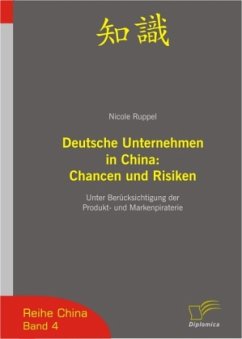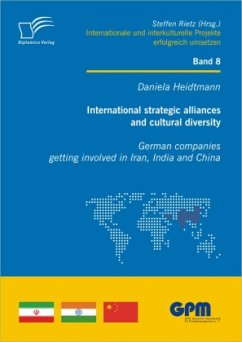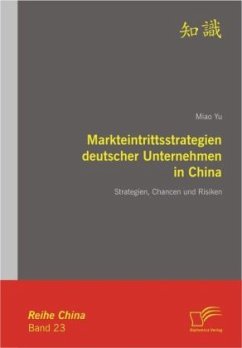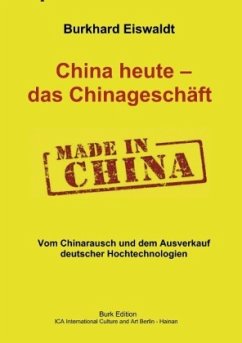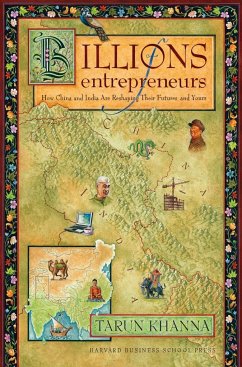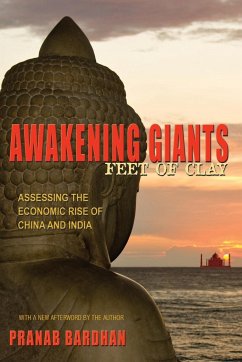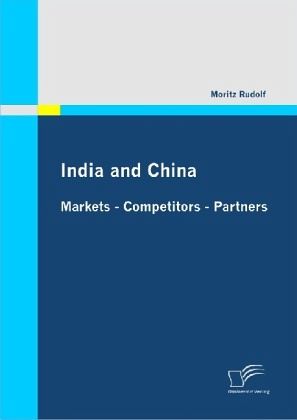
India and China: Markets - Competitors - Partners

PAYBACK Punkte
0 °P sammeln!
Academics, students, the media and the public have been increasingly drawn to China and India in recent years. Both countries were considered sleeping giants and are now turning into the motors of global economic growth. China and India are both ancient civilizations with a rich history and were among the largest economic powers until European colonization in the 19th century. After Indian independence in 1947 and the establishment of the Peoples Republic of China in 1949 both countries shared the view that economic development should be achieved through a self-sustaining economy led and contr...
Academics, students, the media and the public have been increasingly drawn to China and India in recent years. Both countries were considered sleeping giants and are now turning into the motors of global economic growth. China and India are both ancient civilizations with a rich history and were among the largest economic powers until European colonization in the 19th century. After Indian independence in 1947 and the establishment of the Peoples Republic of China in 1949 both countries shared the view that economic development should be achieved through a self-sustaining economy led and controlled by the government. In the following decades the share of Chinese and Indian global trade decreased significantly. Economic reform in China and India in 1978 and 1991 respectively resulted in an increasing integration into global markets and triggered large economic growth.
It is very important to note that although China and India are both rising at the same point of time, they arerising in a different pace. China outperforms India in almost every indicator of economic development. It is the key aim of this study to point out this asymmetry between China and India. Another question is, if India is capable of catching up with China in the future and its effects to Sino-Indian relations.
Die Rolle von China und Indien in der Welt hat sich in den letzten Jahren sehr stark gewandelt. Aus Bittstellern wurden Gläubiger und Motoren für das globale Wirtschaftswachstum.
Dieses Buch setzt sich mit den ökonomischen Asymmetrien die zwischen Indien und China existieren auseinander. Ein historischer Überblick über die mehr als 2000 Jahre zurückreichenden ökonomischen Beziehungen ist der Ausgangspunkt der Studie. Beide Volkswirtschaften werden anhand von ökonomischen Indikatoren wie Wirtschaftswachstum, Reduzierung von Armut, Integration in internationale Märkte, demographischer Wandel, institutionelle Herausforderungen usw. miteinander verglichen.
In einem zweiten Schritt werden die bilateralen Handelsbeziehungen zwischen Indien und China genau analysiert. Mit Hilfe einfacher ökonomischer Methodik werden Gebiete für Kooperation und Konflikte herausgearbeitet und die gegenseitige Wahrnehmung als Handelspartner analysiert.
In einem dritten Schritt werden China und Indien im globalen Handel betrachtet. Hierfür wird die Bedeutung von China und Indien als Import- und Exportpartner für die Welt beschrieben und die am häufigsten gehandelten Produkte systematisch aufgelistet. Dabei lässt sich erkennen in welchen geographischen Gebieten und bei welchen Gütern indisch-chinesische Kooperationen oder Konflikte zu erwarten sind. Eine dynamische Analyse untersucht, ob Indien seinen Rückstand auf China aufholen kann und liefert eine Prognose für zukünftige sino-indische Wirtschaftsbeziehungen.
It is very important to note that although China and India are both rising at the same point of time, they arerising in a different pace. China outperforms India in almost every indicator of economic development. It is the key aim of this study to point out this asymmetry between China and India. Another question is, if India is capable of catching up with China in the future and its effects to Sino-Indian relations.
Die Rolle von China und Indien in der Welt hat sich in den letzten Jahren sehr stark gewandelt. Aus Bittstellern wurden Gläubiger und Motoren für das globale Wirtschaftswachstum.
Dieses Buch setzt sich mit den ökonomischen Asymmetrien die zwischen Indien und China existieren auseinander. Ein historischer Überblick über die mehr als 2000 Jahre zurückreichenden ökonomischen Beziehungen ist der Ausgangspunkt der Studie. Beide Volkswirtschaften werden anhand von ökonomischen Indikatoren wie Wirtschaftswachstum, Reduzierung von Armut, Integration in internationale Märkte, demographischer Wandel, institutionelle Herausforderungen usw. miteinander verglichen.
In einem zweiten Schritt werden die bilateralen Handelsbeziehungen zwischen Indien und China genau analysiert. Mit Hilfe einfacher ökonomischer Methodik werden Gebiete für Kooperation und Konflikte herausgearbeitet und die gegenseitige Wahrnehmung als Handelspartner analysiert.
In einem dritten Schritt werden China und Indien im globalen Handel betrachtet. Hierfür wird die Bedeutung von China und Indien als Import- und Exportpartner für die Welt beschrieben und die am häufigsten gehandelten Produkte systematisch aufgelistet. Dabei lässt sich erkennen in welchen geographischen Gebieten und bei welchen Gütern indisch-chinesische Kooperationen oder Konflikte zu erwarten sind. Eine dynamische Analyse untersucht, ob Indien seinen Rückstand auf China aufholen kann und liefert eine Prognose für zukünftige sino-indische Wirtschaftsbeziehungen.




